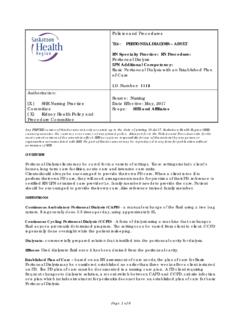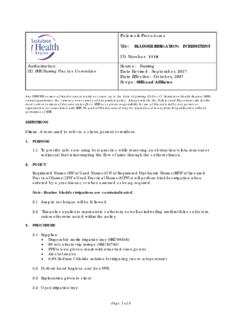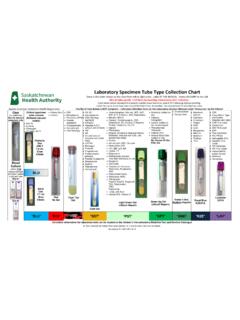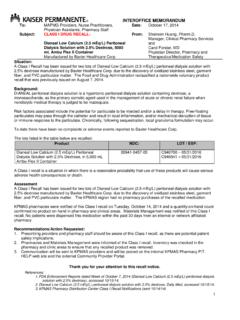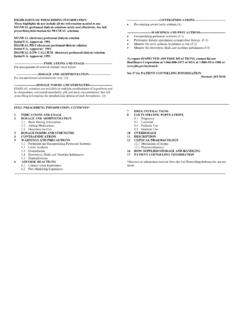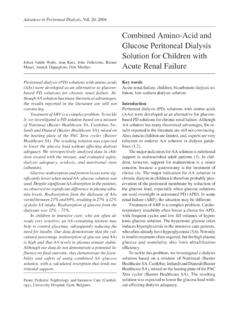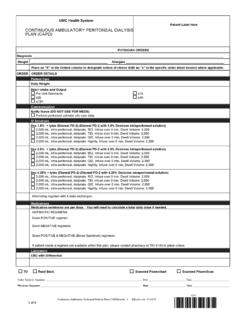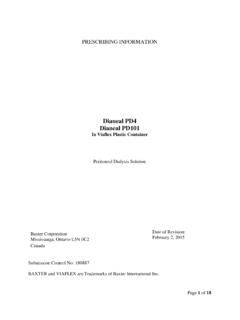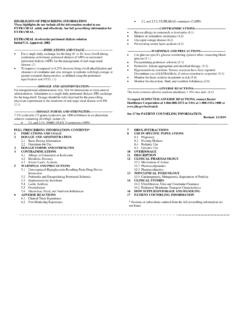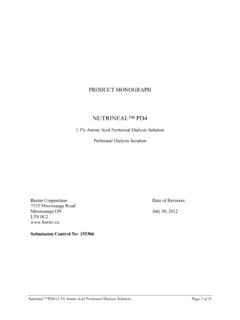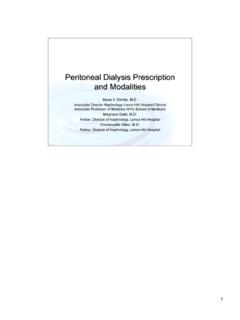Transcription of Policies and Procedures - Saskatoon Health Region
1 Policies and Procedures Title: peritoneal dialysis - ADDING MEDICATIONS TO DIALYSATE Number: 1153 [ X ] Kidney Health Home Based Therapies [ X ] SHR Nursing Practice Committee Source: Nursing Date Revised: May 2017 Date Effective: September 2012 Scope: SHR & Affiliates Any PRINTED version of this document is only accurate up to the date of printing 19-Jul-17. Saskatoon Health Region (SHR) cannot guarantee the currency or accuracy of any printed policy. Always refer to the Policies and Procedures site for the most current versions of documents in effect.
2 SHR accepts no responsibility for use of this material by any person or organization not associated with SHR. No part of this document may be reproduced in any form for publication without permission of SHR OVERVIEW PD patients occasionally need medications added to their dialysate fluid, usually because of peritonitis. The medications added are heparin and antibiotics. Heparin is used to reduce fibrin formation that can form in and around the peritoneal catheter, therefore blocking dialysate flow. Various types of antibiotics may be used. Although the client may be able to perform dialysis treatments, he or she may not know how to or be able to, correctly add medications to the dialysate.
3 DEFINITIONS Dialysate - commercially prepared solution that is instilled into the peritoneal cavity for dialysis . Exchange - the cycle of emptying and refilling of fluid from the peritoneal cavity peritoneal dialysis (PD) - dialysis using a semipermeable membrane (peritoneum) Peritonitis - an inflammation/infection of the peritoneum and the surrounding tissues that can lead to major complications ROLES Registered Nurses, Registered Psychiatric Nurses, Graduate Nurses, Student Nurses and Licensed Practical Nurses and Graduate Licensed Practical Nurses who have successfully completed the IV Therapy Completer Course may add IV medications to peritoneal dialysate fluid bags as per chart in Appendix A.
4 1. PURPOSE To safely add medications to PD dialysate, minimizing complications 2. POLICY As assigned, staff nurses will add prescribed medication to PD dialysate, or assist/supervise the patient to add medications. Policies & Procedures : peritoneal dialysis - Adding Medications To Dialysate #1153 Page 2 of 4 Clients who are on established PD at home, and are knowledgeable, capable and willing to add medications to their own dialysate, may continue to add medications during an acute care admission, at the discretion of the nurse. Trained Family members may add medications to PD dialysate.
5 Medications manufactured for IV route are appropriate to add to peritoneal dialysate solutions , as prescribed. Dialysate bags will be used within 48 hours of the addition of medications, or sooner according to the stability of the medication (see Appendix A). 3. PROCEDURE Wash hands and collect supplies: Medication vial Alcohol swab Syringe of appropriate size Blunt needle (at least 1 inch long) Dialysate bag (of appropriate volume and concentration, per physician s orders) Sterile water or NaCl (as required for reconstitution) Medication label labeled as per medication administration policy Hand sanitizer Perform hand hygiene.
6 Clean top of medication vial for 15 seconds using an alcohol swab and friction in a twisting motion. Allow to dry. Reconstitute antibiotic as per instructions on the vial, or draw up required amount of heparin. Open outer wrap of dialysate bag, and double check for proper dextrose concentration, expiry date, amount of fluid, and if there are any leaks in the bag. Choose another bag if not suitable. Clean medication port on dialysate bag for 15 seconds using an alcohol swab and friction in a twisting motion. Allow to dry. Inject medication into medication port on dialysate bag.
7 Remove needle and syringe and discard in sharps container. Apply medication label. Position container with ports up and evacuate the medication port by squeezing and tapping it. Gently agitate dialysate bag back and forth to mix medication thoroughly into dialysate Continue with dialysis exchange. Perform hand hygiene. Policies & Procedures : peritoneal dialysis - Adding Medications To Dialysate #1153 Page 3 of 4 Complete any required documentation. 4. REFERENCES: Bailie G, Kane M. Stability of Drug Additives to peritoneal Dialysate.
8 Perit Dial Int 1995; 15: 328-335. Bailie, G et al. peritoneal dialysis A Guide to Medication Use. Nephrology Pharmacy Associates, Inc; 2006. Baxter Healthcare Corporation. Prescribing information for dianeal peritoneal dialysis Solution. Last revised Dec 2015. Core Curriculum for Nephrology Nursing, American Nephrology Nurses Association. 6th edition, 2015, Module 3, p247-250. Daugirdas, Blake, and Todd, Handbook of dialysis , 5th ed., 2015, pp 459-512. deVin, F et al. Intraperitoneal Administration of Drugs in peritoneal dialysis Patients: A Review of Compatibility and Guidance for Clinical Use.
9 Perit Dial Int 2009; 29(1): 5-15. Dumler, F et al. Intermittent Intraperitoneal Ceftazidime Dosing in End-Stage Renal Disease. (abstract) ASAIO J 1998 Sep-Oct; 44(5): M411-4. Kam-TaoLi, Szeto, Piraino, et al; ISPD Peritonitis Recommendations: 2016 Nornoo AO, Elwell RJ. Stability of Vancomycin in Icodextrin peritoneal dialysis Solution. Ann Pharmacother 2006; 40(11): 1950-4. Pallotta, K et al. Stability of Tobramycin and Ceftazidime in Icodextrin peritoneal dialysis Solution. Perit Dial Int 2009; 29(1): 52-57. Potter, Perry and Ostendorf, 8th Ed.
10 (2014) Clinical Nursing Skills and Techniques. Elsevier Mosby; St. Louis, Missouri. Ranganathan, D et al. Stability of Antibiotics for Intraperitoneal Administration in Extraneal Icodextrin peritoneal dialysis Bags (STAB Study). Perit Dial Int 2015; PDI in Press. Published on Oct 22, 2015. Retrieved online April 21st, 2017 Stamatakis, W et al. Stability of high-dose Vancomycin and Ceftazidime in peritoneal dialysis solutions . Am J Health -Syst Pharm 1999; 56: 246-8. Update on Prevention and Treatment. peritoneal dialysis International. September-October 2016, vol.
